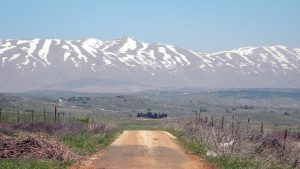Jesus, of course, was fully aware of the ongoing war for his holy mountain. For him, the war was personal.

Many of the key events in the life of Jesus occurred at the Temple Mount. As an infant, Jesus was presented at the Temple in accordance with the Law, where Simeon, a man who had been told he’d live to see the Messiah, and Anna, an 84-year-old prophetess, were led to Jesus by the Holy Spirit. When he was twelve, he stayed behind in the Temple after his parents started back to Nazareth after the Passover celebration in Jerusalem. It was a full day before they realized Jesus was missing, and at least three more before they found him in the Temple talking with the rabbis.
Early in his ministry, Jesus visited Jerusalem during Passover and drove the moneychangers and animal merchants out of the Temple. Later, probably during the second Passover of his ministry, Jesus healed a lame man at the Pool of Bethesda at the north end of the temple complex. Shortly before the Crucifixion, Jesus drove out the moneychangers a second time, and Matthew records that he healed many lame and blind people who came to him at the Temple.
Isn’t it interesting that even in the building erected by the wicked king Herod, and without the Ark of the Covenant in the temple, Jesus was still consumed with zeal for his Father’s house?
And that passion extended beyond the 35 acres that make up the Temple Mount. Israel’s inheritance was Yahweh, and the land inside the borders He established during the time of Moses and Joshua belonged to Him. That’s why Jesus devoted so much of his ministry to healing the sick and casting out demons—which were, remember, the spirits of the Nephilim. He wasn’t just restoring people to physical and spiritual health, he was casting them out of his land, Israel.
When we step back and take a fresh look at the events of Jesus’ life, many things take on new meaning when they’re framed in the context of the war between God and the gods. And, of course, many of the arguments offered by skeptics to explain away the divinity of Jesus are nothing more than PSYOPs by the Fallen to convince modern minds, clouded by the fog of scientism, that Jesus was either a political radical, a social justice warrior, or a misunderstood itinerant preacher—anything but God made flesh.
For example, the Transfiguration. What was the point of all that?
And after six days Jesus took with him Peter and James and John, and led them up a high mountain by themselves. And he was transfigured before them, and his clothes became radiant, intensely white, as no one on earth could bleach them. And there appeared to them Elijah with Moses, and they were talking with Jesus. And Peter said to Jesus, “Rabbi, it is good that we are here. Let us make three tents, one for you and one for Moses and one for Elijah.” For he did not know what to say, for they were terrified. And a cloud overshadowed them, and a voice came out of the cloud, “This is my beloved Son; listen to him.” And suddenly, looking around, they no longer saw anyone with them but Jesus only.
Mark 9:2–8 (ESV)
First reaction by the modern reader: Awesome special effects! But if the purpose of the Transfiguration was to demonstrate his divinity, why did Jesus take only three of his disciples? Wouldn’t it have been more productive to bring all twelve? Or why not perform this great visual effect for the thousands of people who had to settle for a miraculous lunch of bread and fish?
Here’s why: The intended audience wasn’t human.
The clue to the real purpose of the event is the location. Both Mark and Matthew note that the Transfiguration took place on a high mountain. Now, Israel has plenty of mountains, but not many that can be described as high—at least not relative to the rest of the peaks in the land.
Second, note that they climbed a mountain near Caesarea Philippi. That narrows the field. The town was in the northeastern part of the Holy Land, north of the Sea of Galilee and Lake Huleh, in the area we call the Golan Heights. To be precise, Caesarea Philippi sat at the southwestern base of Mount Hermon.
Yes, the very mountain where the Watchers/Titans descended and made a pact to corrupt humanity was where Jesus was transfigured into a being of light before the eyes of Peter, James, and John.
Coincidence? Not on your life! Jesus knew exactly what he was doing. This was a cosmic poke in the eye, a declaration to the Fallen that the Second Power in Heaven, the Messiah, had arrived in the flesh. He was declaring that the temporary dominion of the rebellious bene elohim was nearly at an end—that Yahweh’s mount of assembly would soon fulfill the promises proclaimed by the prophets. And he did it on the mount of assembly of the Canaanite creator-god El.
Mount Hermon was, in effect, the Canaanite Mount Olympus. And it was where the Fallen tried to usurp the name of El Shaddai, the God of Abraham, Isaac, and Jacob.
If we back up a chapter in Matthew and Mark, there is another incident that foreshadowed what happened on Mount Hermon. At the base of the mountain, outside the city of Caesarea Philippi, is a place called Paneas (today called Banias). It’s a cave and a spring that’s been sacred to the Greek god Pan since the time of Alexander the Great.
Pan was the god of wild, desolate places, shepherds and flocks, music, fields, groves, and wooded glens. Pan was also linked to fertility, which influenced much of the art depicting the god in the classical world. He was often shown pursuing or engaged in physical relations with goddesses, nymphs, women, teen boys called eromenoi, and/or goats. (Some of those ancient vases and frescoes should have been rated R or NC-17.) As a rustic nature god, Pan normally wasn’t worshiped in temples. He preferred outdoor settings, especially those that were like his home in Arcadia, a mountainous region of southern Greece.
The Grotto of Pan at Paneas has been sacred since ancient times. A gushing spring once flowed from the cave, feeding the marshy area north of Lake Huleh that was the source of the Jordan River. An earthquake years ago shifted something under the mountain, and today the stream seeps quietly from the bedrock below the mouth of the cave.
After the Greeks came to the Levant, Pan gradually replaced an earlier local fertility cult. Scholars have suggested that Aliyan, a minor Canaanite god of fountains, may have been the deity worshiped at Paneas before the Greeks arrived. This might have been the god called Baal-Hermon, the Lord of Hermon, in Judges 3:3.
Christians in the centuries after Jesus equated Pan with Satan. It doesn’t take a lot of imagination to see how Greek depictions of the goat-god influenced later artists, what with the horns, hooves, tail, and all. But those connections were mainly in the minds of imaginative medieval artists, since there is nothing definite in the Bible that describes the appearance of Satan other than a warning that he can appear as an angel of light.
However, there are some events in Israel’s past that suggest Pan was not at all a fun-loving nature spirit. We’ll address that topic next week.


As always, your lessons are totally enlightening. Thank you.
Derek thanks for posting this info on your blog site. I know this info is available in your various books but this makes it so easy to share with others. Nice concise and shareable. I have a small ministry to witness to various channeling cults specifically the Urantia book followers. The Urantia Book in paper 158 totally redefines and changes the people who where there and the reasons why. I have discussed this with UB followers and this makes it easy for me to say, consider this….God bless.
Thank you! That’s why we share these excerpts–to get the information out there.
I’m sorry but I still do not understand why only 3 were taken instead of the 12? . You made it clear why they went where they did and Jesus was ‘showing the Satans, etc who was the true King.
but I still don’t understand that.
Warm Regards
I literally taught this to my youth group students last Wednesday! Jesus wasn’t in retreat, he was in full assault mode. That region must have been pretty spooky with the dolmens and Gilgal Rephaim in the area known as ancient Bashan. Cool stuff Gilbert! Heard about you from the Blurry Podcast.
Blessings!
Thank you! It’s still kind of spooky today.
Derek. Thank you for these excerpts. It make it easier for me to share with my family and friends. I think maps would be a nice visual touch.
So very interesting. The quest of the lower gods opposing The Son of Man. We know the ending, praise Jesus!
Thank you so much for sharing this precious information.
It’s fascinating!
Let the Lord bless you and your wife.
Greetings from Slovenia.